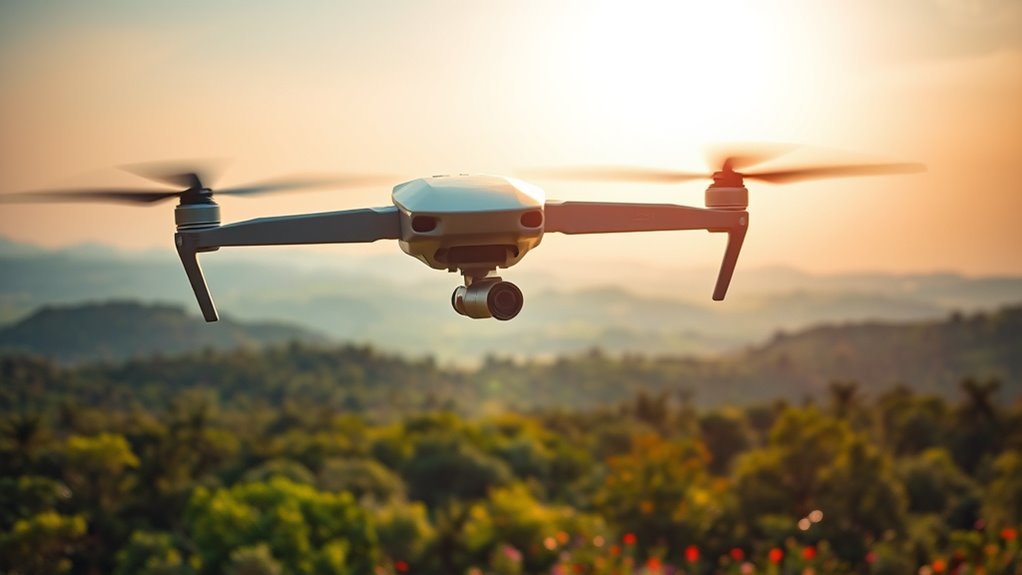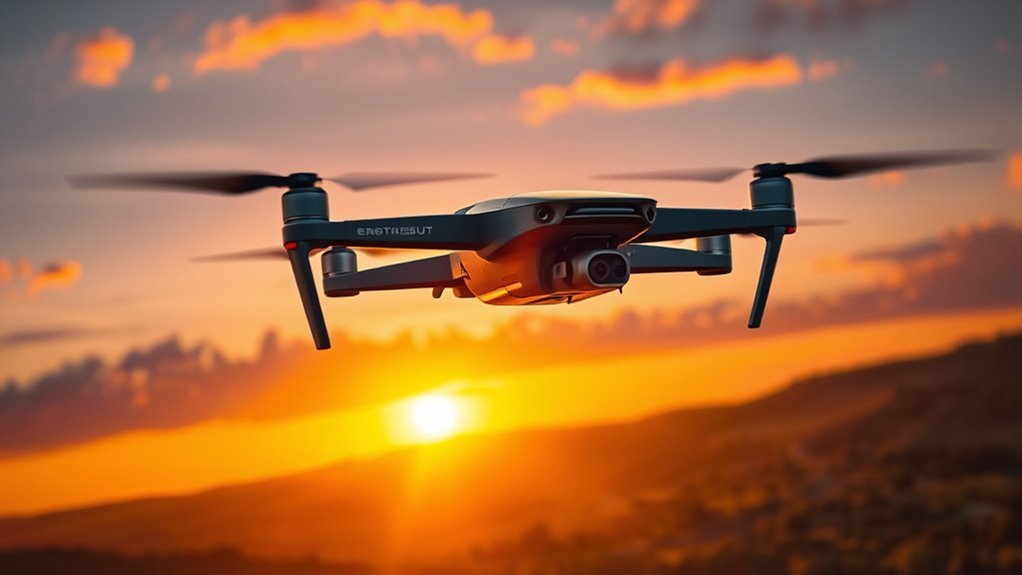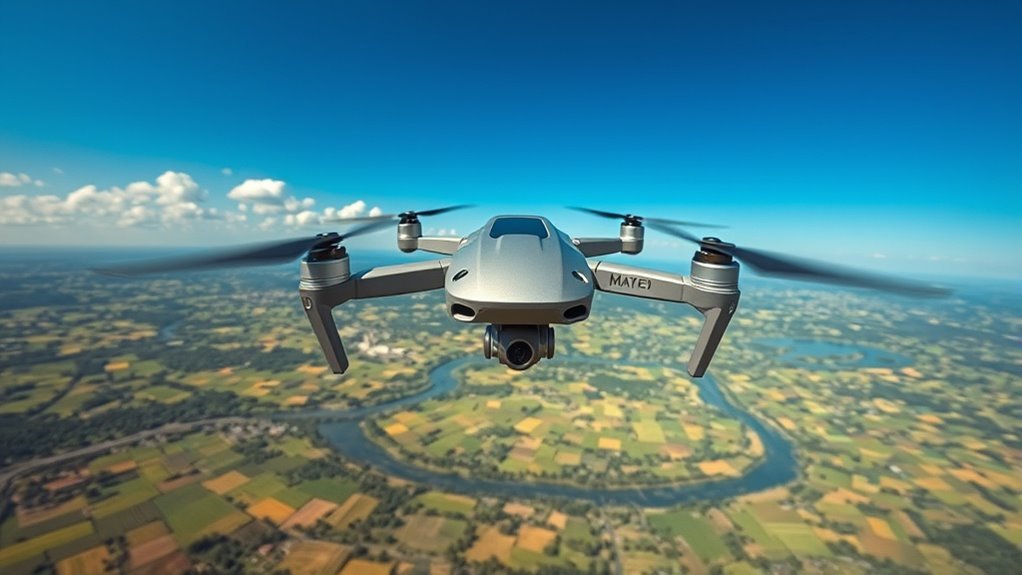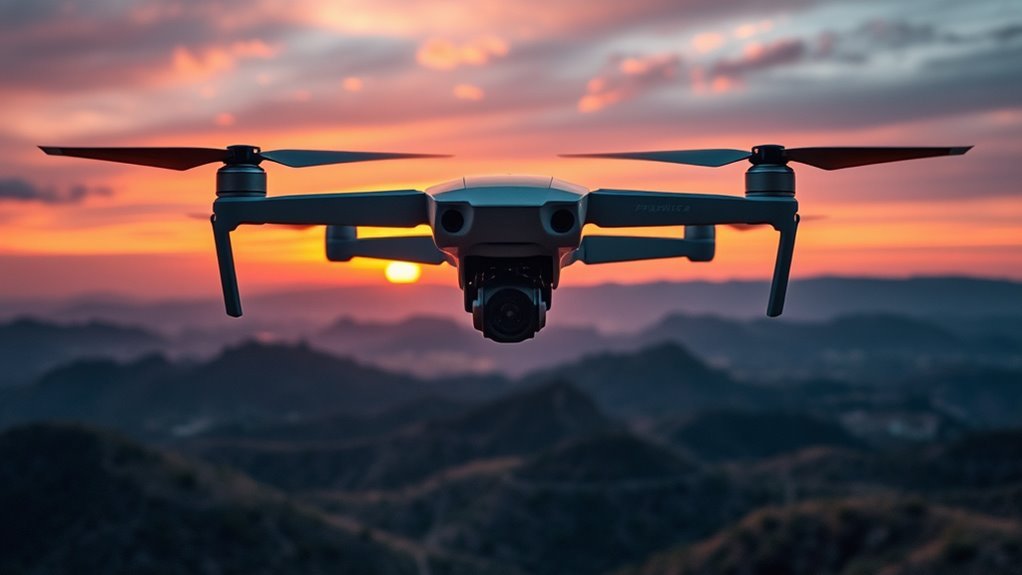The word “drone” translates to “drón” in Spanish. This term is widely used across various contexts, from photography to agriculture and delivery services. Understanding this vocabulary helps you navigate discussions on drone technology, safety, and regulations. For instance, knowing terms like “control remoto” (remote control) and “batería” (battery) is essential. If you’re interested in exploring more about drone applications and their legal aspects, there’s a lot more valuable information available.
The Spanish Translation of Drone

When discussing modern technology, the word “drone” has become increasingly common in everyday language. In Spanish, the term translates directly to “drón,” maintaining the same pronunciation but adapting to the language’s phonetic rules. Understanding drone terminology becomes essential for those steering through this field, as it encompasses various aspects from UAV (Unmanned Aerial Vehicle) to FPV (First-Person View). Additionally, drone slang, like “fly” or “buzz,” can vary by region, reflecting local culture and usage. Being aware of these nuances not only aids in communication but also enriches your understanding of the technology’s implications. Knowing the correct translation and context elevates your conversations, allowing you to engage confidently with Spanish speakers in discussions about drone technology and its evolving landscape.
Usage in Different Contexts

The term “drón” finds varied applications across different contexts, illustrating the versatility of drone technology. In recreational settings, you might use drones for aerial photography or racing, experiencing a sense of freedom as you pilot your device. Meanwhile, in commercial environments, drone applications have transformed industries like agriculture, where they assist in crop monitoring and data collection, optimizing productivity. For instance, drones like the Delair UX11 AG are specifically designed for agricultural purposes, providing high-resolution imaging that enhances decision-making. Law enforcement also benefits from drones, utilizing them for surveillance and search-and-rescue operations, enhancing public safety. Additionally, humanitarian efforts leverage drone technology for delivering aid to remote areas, showcasing its potential to impact lives positively. Understanding these diverse contexts enriches your grasp of “drón” and its significance in today’s world, reflecting a blend of innovation and necessity. Furthermore, drones equipped with multispectral cameras are revolutionizing agriculture by providing real-time insights into crop health and optimizing resource allocation.
Related Vocabulary for Drones

Understanding the varied applications of “drón” paves the way for exploring related vocabulary that enhances your comprehension of drone technology. Familiarizing yourself with terms related to drones can notably improve your knowledge and guarantee drone safety. Here are a few essential terms to reflect on:
| Spanish Term | English Translation |
|---|---|
| piloto automático | autopilot |
| control remoto | remote control |
| batería | battery |
These terms are vital in discussions about drone operations and safety protocols. By incorporating this vocabulary into your language practice, you’ll not only deepen your understanding of drone technology but also engage more effectively in conversations about the responsible use of drones. Additionally, understanding battery capacity is crucial as it directly limits flight time and travel distance on a single charge. The efficiency of energy management plays a significant role in maximizing the drone’s performance and extending its flight time.
Drones in Photography
Frequently, drones are revolutionizing the field of photography, offering unique perspectives and capabilities that traditional cameras can’t match. By incorporating drone photography techniques, you can elevate your work and capture stunning images from above. Here are some essential aerial photography tips to enhance your skills:Drones are transforming photography, providing unparalleled perspectives and techniques to elevate your aerial imagery.
- Plan Your Flight Path: Map out your shots in advance to guarantee you capture the desired angles.
- Utilize Golden Hour: Shoot during sunrise or sunset for the best natural lighting.
- Experiment with Angles: Don’t just shoot straight down; try different elevations and angles for variety.
- Maintain Stability: Use gimbals to guarantee smooth footage and sharp images. Emphasizing the importance of a 3-axis gimbal can significantly improve your image stabilization.
Embrace the freedom drones offer, and watch your photography transform dramatically.
Drones in Agriculture
As agricultural practices evolve, integrating drones into farming operations has become increasingly essential. You’re likely aware of the significant role drones play in precision agriculture. These unmanned aerial vehicles provide real-time data, enabling you to monitor crop health efficiently. With high-resolution imagery, drones facilitate precise assessments of soil conditions, pest infestations, and irrigation needs. Additionally, advanced drone technology enhances data collection, ensuring accurate insights that support sustainable farming practices. Moreover, drones equipped with AI monitoring systems can detect potential threats to crops, allowing for timely interventions and improved yield outcomes.
Drones in Delivery Services
While the agricultural sector benefits from drones for monitoring crop health, another area where these unmanned aerial vehicles are making waves is in delivery services. Drones are revolutionizing drone logistics, enhancing delivery efficiency in ways you might not have imagined. Here’s how they’re changing the game:
Drones are transforming delivery services, boosting logistics efficiency and redefining how packages reach their destinations.
- Speed: Drones can deliver packages faster than traditional methods, with the Amazon MK30 achieving speeds up to 50 mph.
- Cost-Effectiveness: Reduces transportation costs considerably over time, particularly with models like the MK30 that have lower maintenance costs compared to heavier designs.
- Accessibility: Reaches remote areas that are hard to access by road, allowing for greater logistical flexibility with drones like the EHang EH216 that can handle substantial payloads.
- Reduced Traffic Congestion: Alleviates the burden on ground transportation networks, as drones like the Amazon MK30 optimize flight paths for efficient delivery.
Moreover, Amazon’s innovations in delivery drones promise to further transform e-commerce logistics, ensuring a future where freedom of delivery is merely a flight away.
Legal Aspects of Drone Usage
Understanding the legal aspects of drone usage is important for anyone looking to operate these advanced tools responsibly and effectively. You must be aware of regulations governing drone safety and legal compliance in your area. These laws can vary greatly, so it’s essential to stay informed about restrictions on altitude, no-fly zones, and privacy concerns. Ignoring these regulations could lead to fines or even confiscation of your drone. Additionally, obtaining the necessary permits for commercial use is critical if you plan to monetize your drone operations. Familiarizing yourself with local, national, and international laws will not only enhance your freedom to fly but also guarantee that you’re contributing to a safer airspace for everyone. Always prioritize legal compliance to enjoy your drone hobby fully. Additionally, reporting unauthorized drone activity to local authorities is often a safer option than taking matters into your own hands.
Popular Drone Models in Spanish-speaking Countries
When you explore popular drone models in Spanish-speaking countries, you’ll notice that top-selling drones often include brands like DJI and Parrot. Understanding the regulations surrounding these drones is essential, as they can vary greatly across different regions. Additionally, comparing the features and performance of these models will help you make informed choices based on local preferences and legal requirements. Many of these popular drones are equipped with advanced camera capabilities that enhance the quality of aerial photography and videography. For instance, the DJI Mavic 3 Pro features a state-of-the-art camera system that delivers professional-grade footage.
Top Selling Drones
Drones have surged in popularity across Spanish-speaking countries, driven by advancements in technology and increased accessibility. As the drone market expands, several models stand out for their performance and features. Here’s a look at some top-selling drones:
- DJI Mavic Air 2: Known for its compact size and exceptional camera quality, it’s perfect for both amateurs and professionals.
- Parrot Anafi: This lightweight drone offers unique filming angles and impressive flight time.
- DJI Mini 2: A favorite for its portability and ease of use, making it ideal for travel.
- Autel Robotics EVO Lite: With advanced drone technology, it boasts high-resolution capabilities and robust flight performance.
These models reflect the evolving demands of enthusiasts seeking freedom and creativity in aerial photography.
Drone Regulations Overview
As the popularity of drones continues to rise in Spanish-speaking countries, it is essential to navigate the varying regulations that govern their use. Each country has its specific guidelines, often focusing on drone safety to protect both operators and the public. In many places, you’ll find requirements for registering your drone and obtaining permits for commercial use. Additionally, drone insurance is becoming increasingly important, as it can mitigate financial risks associated with accidents or damage. Understanding these regulations not only helps you fly legally but also promotes responsible drone operation. Staying informed about local laws will empower you to enjoy the freedom that drones offer while ensuring the safety of those around you.
Popular Brands Comparison
The landscape of popular drone models in Spanish-speaking countries reflects a diverse range of preferences and technological advancements. You’ll find that different regions prioritize various aspects of drone technology, which influences their choices. Here are four popular models worth considering:
- DJI Mavic Air 2 – Known for its compact design and impressive camera quality.
- Parrot Anafi – Offers unique features like a 4K HDR camera and 180-degree tilt gimbal.
- DJI Phantom 4 Pro – Recognized for its advanced obstacle avoidance and high-level drone safety features.
- Holy Stone HS720 – A budget-friendly option with solid performance and reliable safety protocols.
Understanding these models can empower your decision-making process, ensuring you select the right drone that aligns with your vision of freedom in aerial exploration.
Tips for Communicating About Drones in Spanish
When discussing drones in Spanish, it’s essential to familiarize yourself with both the vocabulary and context in which these terms are used. Understanding drone technology and drone safety concepts will enhance your communication. Here’s a quick reference table to guide you:
| English Term | Spanish Translation |
|---|---|
| Drone technology | Tecnología de drones |
| Drone safety | Seguridad de drones |
| Remote control | Control remoto |
| Aerial footage | Imágenes aéreas |
Using these terms appropriately will empower you to engage in informed discussions about the implications of drone usage. Remember to reflect on regional variations in vocabulary and context, ensuring your communication resonates well with your audience.
Frequently Asked Questions
What Is the Origin of the Word “Drone” in Spanish?
The etymology exploration of “drone” reveals its roots in the Latin “drone,” linked to buzzing sounds. Language evolution shows how terms adapt, reflecting technological advancements and cultural shifts in contemporary communication and expression.
Are There Regional Variations in the Spanish Term for Drone?
Diverse drone terminology differences do exist across Spanish-speaking regions, showcasing striking regional slang variations. You’ll find terms like “dron” in most places, but local nuances might surprise you as you explore this fascinating linguistic landscape.
How Do You Pronounce “Drone” in Spanish?
To understand drone pronunciation in Spanish, focus on the phonetics: it’s pronounced “droh-neh.” Emphasizing the ‘o’ sound is essential, as Spanish vowels are typically clearer and more distinct than in English. Pay attention to these nuances!
Can I Use “Drone” in Informal Conversations?
Can you really use “drone” in casual chats? Absolutely! In informal usage, drone terminology is widely accepted, making conversations feel modern. Just guarantee your audience understands the context, and you’ll engage them effortlessly.
What Are Common Misconceptions About Drones in Spanish-Speaking Countries?
You might think drones are universally safe, but misconceptions abound. In Spanish-speaking countries, regulations can vary considerably, leading to confusion about their safety and legal use. Understanding these nuances is essential for responsible drone operation.

